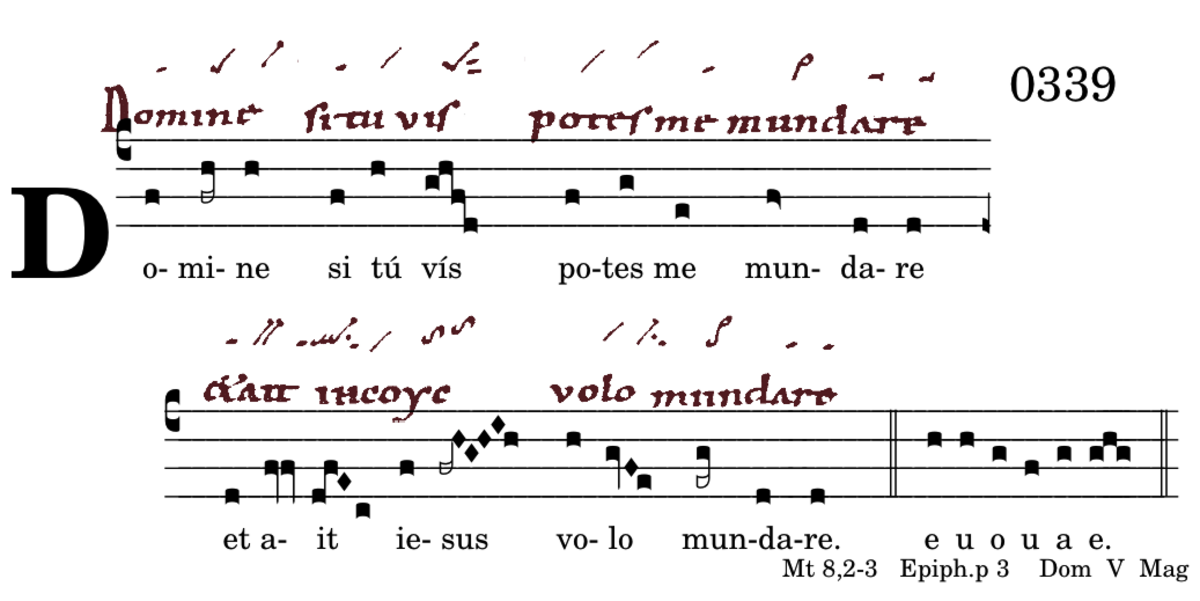🔘 IN GR TR AL OF CO xxxxx ✅ 2️⃣ 0️⃣ 3️⃣ 4️⃣ 5️⃣ 6️⃣ 7️⃣ 8️⃣ xxxxx AN RP IV alia
0339 AN Domine si tu visModus 1
1FML alloq „Dómine“
1MED triv +
1FML quia +
1FML SolMiDo
Eine geniale Lösung. Die steile Fügung „si tú vís“ ist durch die zweiakzentige Form (M-Form) des Cento vertont. Dazu kommt der Absprung zum re: Doppelpunkt. Dieser nur dreisilbige Text wird trotz seiner Kürze der Melodie 1BIN triv unterlegt, die letzten Töne durch Synärese auf eine Silbe gebracht. Es entsteht ein nkPes subpunctis, die Neume, die theologisches Schwergewicht ausdrückt: „wenn Du willst…“.

1TER conc Dieser Cento nimmt im Gegensatz zur fictio den Akzent „me“ zurück, was einem Bettler wohl ansteht.
Hier sei an die wissenschaftliche Auseinandersetzung Ende des vergangenen Jahrhunderts zwischen Godehard Joppich und Kees van Puderojen erinnert. Joppichs Behauptung, bestimmte Neumen hätten sinntragenden Charakter, wie hier der Pes subpunctis, wurde von Puderojen heftig widersprochen mit der Begründung, diese Neumen entstünden meist bloß durch Synärese, weil der Text zu kurz ist, bedeuten daher gar nichts. Unsere Untersuchungen zeigen, dass solche Synäresen nicht zufällig passieren, sie sind beabsichtigt. Der „Komponist“ hätte ja auch einen anderen (geeigneteren?) Cento verwenden können.
FML digit
FML quia Jesus in voller Würde und Macht (FML quia) nimmt Lehrhaltung ein (FML digitus), um ganz schlicht zu sagen:
1TER de5 „vólo mundáre“. Ganz schlicht, aber nicht gewöhnlich: die Töne des Cento werden so umgruppiert, das „vólo“ mit Climacus ausklingt (Climacus, die vergrößerte Clivis hat deren Eigenschaften verstärkt: verbreitert ohne zu betonen und führt weiter). Jesus spricht leise, aber mit Macht: die den Schlussakzent vorbereitende Clivis „fa-mi“ (bzw. Cephalicus „fa“) wird ausgelassen, die Liqueszenz auf „mun-dáre“ lässt ahnen, das hier etwas ausgelassen wurde. Der Quartfall hat etwas Endgültiges.
● Herr, wenn du willst, kannst du mich rein machen
und Jesus sagte: ich will, sei rein.
● Lord, if you want to, you can make me clean
and Jesus said: I will, be clean.
1FML alloq „Dómine“
1MED triv +
1FML quia +
1FML SolMiDo\
An ingenious solution. The steep inflection „si tú vís“ is set to music by the two-accent form (M form) of cento. Then there is the leap to the re: colon. Despite its brevity, this text of only three syllables is underlaid with the melody 1BIN triv, the last notes brought to one syllable by syneresis. The result is an nkPes subpunctis, the neume, which expresses theological emphasis: „wenn Du willst…“.

1TER conc In contrast to the fictio, this cento takes back the accent „me“, which is probably appropriate for a beggar.
Here it is worth recalling the scholarly debate at the end of the last century between Godehard Joppich and Kees van Puderojen. Joppich's assertion that certain neumes have a meaning-bearing character, such as the pes subpunctis here, was fiercely contradicted by Puderojen on the grounds that these neumes usually only arise through syneresis because the text is too short and therefore mean nothing at all. Our research shows that such syneresis does not happen by chance, it is intentional. The „composer“ could have used a different (more suitable?) cento.
FML digit
FML quia Jesus in full dignity and power (FML quia) assumes a teaching posture (FML digitus), to put it simply:
1TER de5 „vólo mundáre“. Very simple, but not ordinary: the notes of the cento are regrouped so that „vólo“ ends with climacus (climacus, the enlarged clivis has reinforced its characteristics: broadens without emphasising and continues). Jesus speaks quietly, but with power: the clivis „fa-mi“ (or cephalicus „fa“) that prepares the final accent is omitted, the liquescence on „mun-dáre“ suggests that something has been omitted here. The fourth case has something definitive about it.

